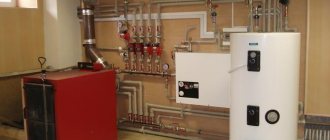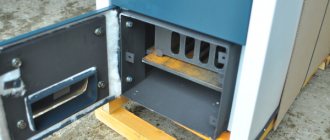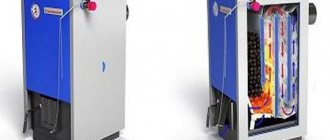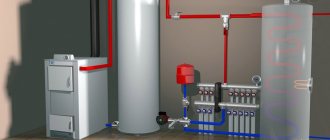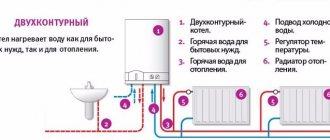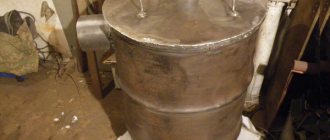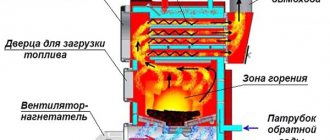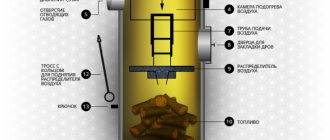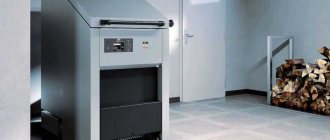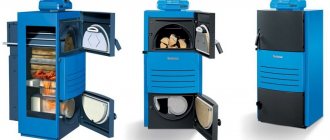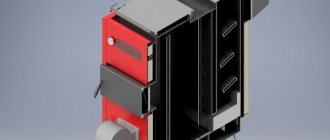Cleaning the igniter, burners with nozzles
If the igniter functions well and without failures, then its flame resembles a cone with a blue tint.
If it is yellow, this indicates only one thing - the burner is dirty. In order to clean the igniter, you need to perform a series of sequential actions:
- it is necessary to shut off the gas supply to the boiler;
- unscrew the igniter;
- Using a metal brush, you need to clean the device well;
- Next you need to blow out the igniter and return it to its place.
A part such as a burner is a very important element of wall-mounted and floor-mounted gas boilers.
Set of brushes for cleaning the boiler
To clean the burner you need:
- close the gas supply valve and remove the device;
- Next, you need to carefully unscrew the nozzle;
- the nozzle cleaning process is carried out using a brush;
- to clean the burner itself, you need to use a brush, and its hole needs to be blown out with a handy pump;
- then return the nozzle and burner to their place.
Where to begin
Before you start cleaning a gas boiler, it is worth understanding how this equipment is equipped. It contains the following components that require periodic cleaning:
- burner with nozzles;
- igniter;
- heat exchanger;
- gas filter;
- firebox;
- chimney.
Read also Milk mushroom caviar for the winter
To clean the equipment, you will need to prepare all the necessary tools:
- plastic or metal brush for cleaning the chimney;
- scrapers;
- steel rope;
- special hooks;
- holders for brushes of various lengths.
The cleaning process itself will be reduced to the following steps:
- Closing the gas supply valve.
- I dismantle the boiler door, nozzles, and burner tube.
- Removing the top cover of the equipment.
- Removing the insulation sheet.
- Carrying out the dismantling of the chimney.
- Choosing a metal brush.
- Carefully clean the heat exchanger from soot.
- To clean the heat exchanger channels, use a vacuum cleaner.
- Cleaning the walls of the boiler with a scraper and brush and wiping with a rag.
- We clean the chimney using a brush with a long handle.
- Reassemble all boiler components in reverse order.
Attention: when disassembling gas equipment, carefully remember the location of all parts and components.
How to clean individual units of the unit
Let's look at how to clean individual components of the unit if they become clogged and stop working properly.
When the igniter is in normal condition, the flame will have a blue tint. If, during operation of the heating equipment, the flame turns yellow, it’s time to clean the igniter. The procedure for cleaning the igniter boils down to:
- Blocking the flow of gas to the equipment.
- Unscrewing the igniter.
- Thoroughly clean the igniter from soot and dirt with a wire brush.
- Blowing out the igniter.
- Installing it in its original place.
If you need to clean the burner with nozzles, you will need:
- Shut off the gas supply.
- Remove the burner.
- Carefully remember the location of the injectors and carefully unscrew them.
- Clean the injectors with a brush.
- Clean the burner with a brush.
- Blow out the burner hole with pumping equipment.
- Insert the injectors into place.
- Install the burner.
Important : the burner with nozzles must be cleaned at least once a year, before the start of the heating season. The gas filter cleans the gas from impurities and contaminants and must be cleaned regularly.
The heat exchanger can become clogged both inside and outside. Its outer part becomes dirty with soot, and its cleaning is carried out mechanically. To effectively clean the heat exchanger, you will need to stock up on the following tools:
- scraper;
- wire brush;
- ruffs of various shapes;
- power tools and cleaning attachments.
The cleaning procedure boils down to:
- Disconnecting the boiler from electricity and gas supply.
- Removing the heat exchanger.
- Clean it with previously prepared tools.
- Installing the unit in its original place.
Attention : when cleaning the heat exchanger, it is recommended to use a tool without sharp edges. If the unit is damaged, it will lead to corrosion.
The cause of internal clogging of the heat exchanger is most often scale and will require dry cleaning using:
- adipic acid;
- sulfamic acid solution;
- special gel.
Attention : it is necessary to select chemicals depending on the degree of contamination of the heat exchanger.
As for cleaning the firebox and chimney, the collection of soot on their walls reduces the functioning of the boiler, so it is recommended to clean the chimney soot regularly.
Contact a professional or do it yourself
Professional cleaning of heating boilers is an expensive proposition. Depending on the condition of the equipment and the specifics of its operation, amounts can range from several tens to hundreds of dollars. In addition, the masters rarely arrive within the next few hours; sometimes you have to wait for them for several days. It is not comfortable.
The cost of professional cleaning using a special station for washing heat exchangers pays off: the parts are washed from the inside to a shine, and the equipment works much better. But if you want, you can always save money and do the same thing yourself. The result will be no worse, and you will only have to invest your own time and effort.
Professional device for washing heat exchangers
Cleaning soot from a wall-mounted heat generator
Getting to the main heat exchanger of most wall-mounted gas boilers is quite simple. The work algorithm is as follows:
- Turn off the gas supply by closing the appropriate tap.
- Remove the front panel of the unit.
- Unscrew and remove the front cover covering the combustion chamber.
To prevent the soot being cleaned from falling into the holes of the gas burner device and then you don’t have to think about how to remove the burner to clean it, you need to cover the nozzles with a sheet of thick paper or cardboard. After that, use an old toothbrush to clean the fins of the heat exchange unit from carbon deposits. If the stuck layer cannot be removed, you can use a brush with soft metal bristles.
When finished, sweep the inside of the unit with a brush and carefully remove the sheet of paper with soot. How to service a wall-mounted boiler is shown in detail in the video:
Do-it-yourself heating flushing
For self-flushing radiators, mechanical cleaning technology is most applicable. In this case, you will not have to use any special equipment or specific chemicals. Before you wash the heat exchanger of a gas boiler with your own hands, you should prepare the necessary materials:
- rags or old thick clothes. With their help, it will be possible to protect the bathtub from damage during the process of flushing the radiators in it;
- fum tape or plumbing linen with a tube of sealing paste;
- a pipe that allows you to connect a hose to threaded connections.
The equipment you will need is the following:
- two hoses;
- a set of keys;
- brush;
- steel wire brush;
- buckets, basin and rags.
The actual cleaning of the heat exchanger and lines consists of several stages.
- A hose of the appropriate diameter is connected to the drain pipe of the heating system. The other end of the hose is discharged into the sewer.
- A second hose is connected to the highest point of the system. As a rule, such a point is either a branch to the expansion tank or a safety group. The tank or safety group is unscrewed and a pipe is screwed into its place, onto which a hose is put. The second end of the hose is connected to the water supply.
- When everything is ready, water is supplied to the system. This makes it possible to get rid of scale and contaminants deposited in the system lines.
- Start draining the coolant. To do this, remove the hose through which tap water was supplied. The connection point to the system is not blocked. Under the influence of gravity, water begins to drain through the drain pipe at the lowest point of the line.
To completely drain the coolant, it is necessary to ensure that the outlet end of the hose is below the level of the heating system lines. In a private house, it will be possible to achieve such a configuration if you drain the water into buckets installed in the underground.
Radiators are removed from the dehydrated system
Care must be taken when doing this. It is likely that the threaded connections on them are coked and you will have to make some efforts, trying not to damage the threads. The removed radiators are transferred to a bathtub, previously covered with rags or thick fabric. Here they are washed with running water, treated with a brush and a steel wire brush.
After flushing the radiator, it is carefully inspected again for any remaining contaminants. Radiators are installed in place
Here they are washed with running water, treated with a brush and a steel wire brush. After flushing the radiator, it is carefully inspected again for any remaining contaminants. The radiators are installed in place.
The lines are filled with fresh water through the drain pipe. At the same time, monitor the formation of air pockets in the pipes and radiators. You can get rid of air bubbles by slightly opening the Mayevsky valves on the radiators. As soon as the air stops hissing and water begins to ooze from the tap, close it. As the lines fill, it is advisable to repeat this procedure several times. After the actual washing of the gas boiler heat exchanger is completed with your own hands, the heating system is put into operation. As the coolant begins to circulate, air pockets in the radiators may re-form. To eliminate them, the Mayevsky cranes are manipulated again. Some of the air will be removed independently through the air vent. As the pipelines and radiators are freed from air, the coolant pressure will drop. To level it, it is necessary to additionally pump water from the water supply. In addition, you should check the pressure in the expansion tank.
What is the difference between chemical cleaning and mechanical cleaning?
Gas equipment can be cleaned in the following ways:
- mechanical;
- chemical;
- electric discharge;
- hydrodynamic.
Attention : if you are not sure that you can cope with cleaning a gas boiler on your own, invite specialists. When cleaning gas equipment, you should wear gloves and protective clothing, as many products are hazardous to the skin.
Mechanical cleaning is carried out using various brushes and scrapers using physical force. The process is quite lengthy and must be carried out with care so as not to damage equipment parts. As a rule, tools for mechanical reading of the unit come with it. These include: wire brushes, brushes and scrapers.
Mechanical cleaning of the boiler is carried out with brushes and abrasives. If the soot layer is small and amounts to no more, you can use simple soda. Please note that when cleaning the boiler, it is necessary to remove not only soot, but also scale from the water. You can clean scale from the heat exchanger mechanically or chemically.
Mechanical cleaning involves regular washing of the heat exchanger with running water, and chemical cleaning involves the use of acid mixed with water.
Attention : gel compositions do not require dilution with water; they can be added to the heat exchanger immediately after it has cooled. They are not highly efficient, but are gentle on metal.
Experts recommend using dry cleaning only for heavily soiled areas - chemicals corrode not only soot, but also metal. Although diluting chemicals with water reduces the harmful effects on the metal, it is impossible to make them completely safe.
Read also Ficus pumila var awkeotsang
Mechanical cleaning
Mechanical cleaning of the chimney from soot is the most common method. This method allows you to achieve maximum results with minimal financial investment. However, the work itself is labor-intensive and dangerous, since the pipe is cleaned from the roof.
Mechanical cleaning equipment
To clean the smoke duct mechanically, you will need to purchase or build yourself a special device, which includes:
- metal cable or strong rope. The length of the cable is selected depending on the height of the smoke channel;
- a rectangular or round brush (brush) depending on the cross-section of the chimney, which can be made of metal or plastic. It is through the brush that the pipes are cleaned;
Metal brushes are used to clean brick and reinforced concrete chimneys. For smoke exhaust ducts made of stainless, ceramic or sandwich pipes, it is recommended to use plastic brushes.
- weighting material The device is required for cleaning pipes from bulky contaminants and as a tool to facilitate the passage of the brush. Any object can act as a weighting agent. The main thing is that the symmetry of the cleaning device is not disturbed;
- carabiners for connecting individual elements into a finished tool.
Special device for cleaning chimneys
Work methodology
Cleaning work is carried out in the following order:
all revisions provided for by the design of the smoke exhaust duct are closed. The furnace firebox is covered with a damp cloth. All of the above work is carried out to protect individual interior elements from soot, which is quite difficult to wash off; a chimney sweep equipped with a cleaning tool climbs onto the roof
It is important to follow safety precautions. Namely: the person carrying out the cleaning work must have fall insurance, the chimney sweep's skin and eyes are protected by glasses, as well as clothing accordingly (not neglecting gloves);
Chimney sweep insurance against falling from the roof
A person who is ill, under the influence of medications that reduce the level of reaction, or under the influence of alcohol or drugs should not clean the chimney.
- the head is removed. If necessary, the head and the space around it are cleaned;
Preparing the pipe for cleaning
- a test lowering of the tool into the pipe is performed. At this stage, the pipe is punched and large contaminants are removed;
- a brush is lowered into the pipe and complete cleaning begins with up and down movements;
- the head is installed;
- Using a dustpan and a regular brush, inspection hatches and the firebox are cleaned.
Cleaning the firebox from accumulated soot
Roof brushing is the most common method. However, if there is a strictly vertical chimney, cleaning work can also be done from the firebox. This requires more complex and expensive equipment, as well as a certain skill in performing the work. Therefore, it is not recommended to use this method yourself.
Cleaning the chimney from below
Another mechanical method is vacuum cleaning, which is carried out from the roof or from the firebox using special equipment. Since this method is labor-intensive, requires the purchase of equipment and has a high level of danger, it can only be used by professionals.
Chimney cleaning with special equipment
How to independently make a tool for cleaning a smoke exhaust duct from a plastic bottle and do the work, watch the video.
Mechanical cleaning
Mechanical cleaning of the boiler furnace is the removal of soot using specialized tools that effectively perform their function without causing harm to the internal surface of the combustion chamber.
Our specialists use a variety of brushes and scrapers, which differ in both size and the nature of the pile.
This way, you can get more work done while still dealing with different types of contaminants, even in hard-to-reach places.
The handle of the tool is designed so that, depending on the situation, its length can be changed.
How often do you clean the heat exchanger in a gas boiler?
The frequency of cleaning the heat exchanger depends primarily on the type of coolant and the design features of the unit itself. It is least common to service single-circuit boilers in heating systems that use purified water as a coolant. To keep them in good condition, it is enough to carry out preventive maintenance once every 4 years.
If untreated water circulates in the system, the boiler should be flushed once every 2-3 years. If the water is hard, then the cleaning regime is once every 2 years. The secondary heat exchanger of a double-circuit boiler must be washed with the same frequency, because unfiltered tap water with impurities flows through it.
Most often, maintenance is required for equipment in heating systems where antifreeze is used as a coolant. It should be washed at least once every 2 years. In addition, you have to monitor the expiration date of antifreeze and replace it in a timely manner. Otherwise, the efficiency of the system will decrease and heating costs will increase.
When cleaning heat exchangers, pay attention to the appearance of the boilers and nozzles and, if necessary, carry out repair work. You should also monitor the condition of chimneys and clean them of soot in a timely manner.
These simple measures extend the life of heating equipment and prevent breakdowns.
Antifreeze for heating systems
When is the best time to service your boiler: spring, summer or autumn?
Most homeowners think about diagnosing their boiler equipment before the start of the heating season, usually in September. It is not difficult to guess that it is during this period that the workload of technical specialists is at its maximum and you may have to wait for their arrival for several days. By ordering this service in spring or summer, these problems can be avoided. Moreover, most likely the price of their work will be lower.
In general, experienced specialists advise doing boiler diagnostics twice a year: at the end of summer and beginning of spring. In the first case, the boiler is prepared for the heating season. Upon arrival at your home, a technician will take care of a professional inspection of your boiler before the next season. In addition to cleaning the boiler, he will carry out diagnostics and check every part and device to eliminate the risk of boiler breakdown in the next heating season. To do this, both the boiler and the burner are dismantled, cleaned and diagnosed. This allows you to detect any defects and repair or replace individual parts if necessary.
Remember: manufacturers of boilers and parts for them provide a guarantee only if heating devices are regularly checked by authorized specialists.
Boiler diagnostics at the beginning of spring are somewhat different. In this case, specialists pay more attention to diagnosing corrosion (which often occurs due to changes in humidity) and cleaning the heating device from accumulated soot and contaminants (during the winter period of boiler operation).
And lastly: manufacturers of modern boilers assure us that these devices can serve us for 10, 20, and even 30 years. However, for some reason they are willing to give a guarantee only for the first 1-2-3 years. The same goes for original parts. Isn't this something to think about?
It is obvious that the service life of boilers, no matter how reliable they are, is limited. Fortunately, it can be extended and achieved within the stated time frame if you regularly clean and maintain your boiler.
Regularity of cleaning and which units need it
The frequency of the procedure for each gas boiler is individual and depends on the following factors:
- equipment power,
- pipeline condition,
- fuel quality,
- hardness and purity of the coolant,
- the material from which the heat exchanger is made,
- radiator designs,
- length of pipe lines,
- duration of operation of the boiler,
- device operating mode.
It is recommended to carry out the cleaning procedure before the start of the heating season or as needed.
The frequency of cleaning a gas boiler depends on many factors
All equipment elements need to be cleaned from combustion products:
- heat exchanger,
- igniter,
- boiler,
- burner,
- gas filter,
- firebox
Below we describe all the nuances of the procedure for a particular node.
Heat exchanger
You can clean the heat exchanger of a gas boiler in different ways, but most often at home they choose mechanical cleaning. To do this, you need to prepare a screwdriver and wrench, a brush and a metal brush. To begin with, the gas supply and sensors are turned off and the boiler lid is removed. The heat exchanger is dismantled and the internal and external parts are cleaned using the prepared devices.
To avoid damage to the heat exchanger, mechanical cleaning should be gentle and tools should not have sharp edges.
Igniter
Cleaning the igniter is performed when the burner flame burns unevenly and has a yellowish color. This means that the hole or injectors are clogged with soot and soot. To clean the igniter of a gas boiler, you need to turn off the fuel supply, remove the igniter and clean it with a brush. Upon completion of the procedure, the part is installed in place and its functionality is checked.
Burner
A burner with nozzles is the main element of a gas boiler, through which fuel is supplied. You can clean the gas boiler burner yourself by following these steps:
- the gas supply is cut off,
- the element is removed from its installation location,
- Marker marks the location of the injectors, which are then carefully removed,
- the burner is cleaned with a brush, and its hole is purged with a pump,
- nozzles are inserted into the burner according to the markings,
- the burner is installed back.
Gas boiler burner
As with cleaning other parts, it is recommended to clean the burner 1-2 times a year.
Boiler
In the case of wall-mounted units, cleaning should not be difficult. You should close the gas valve, remove the front panel and the cover covering the combustion chamber. In order to protect the burner from soot that will fall during the cleaning process, it, together with the nozzles, is covered with a sheet of paper. Using a bristle brush, the boiler fins are freed from carbon deposits. At the end of the process, the inside of the device is swept, the sheet with soot is carefully removed.
Gas filter
The gas filter plays an extremely important role in the operation of the boiler. It cleans the incoming fuel from various types of contaminants and impurities. This promotes efficient operation of the device and reduces the appearance of deposits on internal parts and the gas outlet pipe
Therefore, it is very important to regularly clean the filter from accumulated clogging.
In addition to gas filters, do not forget about cleaning water filters from scale. They are meshes that are removed and washed with running water.
Rusty deposits can be easily removed with citric acid if you soak the filters in its solution.
Firebox
A firebox and chimney clogged with soot are extremely ineffective. A decrease in draft is dangerous for the further use of the boiler, because may cause carbon monoxide to enter the living space. Large amounts of soot can ignite under unfavorable conditions.
The firebox is cleaned with brushes. You can clean the chimney from the inside yourself, but to clean it from the outside it is better to contact a specialist. To prevent the upper part of the chimney from becoming covered with ice, it is recommended to insulate it.
Scheduled or preventative cleaning of a gas heating boiler will help you use the equipment as efficiently as possible without reducing the level of comfort for the residents of the house.
Cleaning the boiler: step-by-step instructions
Before performing any work, the gas supply valve must be closed, the boiler must be disconnected from the electrical network, the supply and return, the DHW circuit, and make-up must be closed.
To gain access to all parts and assemblies, the front panel is removed, which is usually secured at the bottom with two bolts. Some models may also have a safety cover installed inside.
Turbine
The turbine, if it is structurally provided for in a particular model, is located under the firebox, next to the exit to the chimney. Evidence of its clogging is the appearance of a hum and uneven noise from a working boiler.
To clean, perform the following steps:
- The turbine is removed; to do this, you need to unscrew the screws and disconnect the condensate receiver.
- On the reverse side of the element there is a fan, the blades of which are freed from dirt and dust with any suitable brush.
- The bearings are lubricated, the turbine is put in place.
Gas boiler turbine
Heat exchanger
Sure signs of clogging are decreased performance, increased fuel consumption, noise, and operation of the circulation pump at high speeds.
The heat exchanger becomes clogged both outside and inside. For the outer surfaces of the element, mechanical cleaning is performed; for the internal volume, it is necessary to wash it using a hydrodynamic, electric discharge or chemical method.
To work you need to prepare:
- wrench of the corresponding number;
- brush-brush;
- lint brush for metal;
- flat screwdriver.
The actions are performed in this order:
- The fuel supply to the boiler is shut off and the power supply is turned off.
- To access the element, you need to remove the front panel of the combustion chamber. Some models require removal of the top cover.
- The heat exchanger plates are cleaned with a bristle brush, first along, then across. In order not to bend or damage the ribs, you need to work carefully, without applying excessive force.
- In double-circuit boilers, the DHW heat exchanger, usually located in the lower half of the housing, also requires cleaning.
Cleaning the heat exchanger plates with a brush
For electric discharge washing, special equipment such as “Streamer” is used. The procedure is performed in specialized workshops or service centers. It is impossible to do it on your own.
Hydrodynamic flushing consists of cleaning the internal volume of the heat exchanger with a water flow supplied under high pressure, removing salt deposits and other contaminants. To perform it, an expensive booster is required, so it is unlikely that you will be able to do the work yourself. But there is no need to transport the heat exchanger anywhere; the procedure is carried out at the customer’s home by a team of specialists.
Chemical cleaning can be easily done on your own. To do this you need to do the following:
- The water is drained from the boiler and the pressure is released.
- Temperature and flow sensors from the pipes are turned off.
- The fasteners are disconnected and the pipes are removed.
- The heat exchanger is immersed in a vessel with a solution of hydrochloric or citric acid and soaked for 30-45 minutes.
- The plaque remaining on the outer walls and plates is removed with a brush, and the coil is washed from the inside.
Flushing the heat exchanger
At the end of all procedures, the heat exchanger is washed with warm water and dried before reinstallation.
You can read more about cleaning the heat exchanger in our separate article.
Burner and nozzles
The burner is designed to continuously supply fuel to the combustion chamber and is the main element of both floor-standing and wall-mounted gas boilers. Signs of clogging are problems with ignition or its impossibility, as well as ignition of gas with popping noise.
The burner and nozzles are cleaned as follows:
- The gas supply valve is closed.
- The burner is removed from its place.
- After marking the exact location, the nozzle is unscrewed and carefully cleaned with a brush.
- To clean the burner, a brush is used, the channels are purged with any available pump.
- The nozzle is inserted into the burner according to the previously made mark.
- The burner is installed in its place.
Burner purge
The burner must be cleaned before the start of each heating season.
Igniter
The stable operation of the igniter is indicated by the bluish flame of the burner in the shape of a cone. If the fire has acquired a yellowish tint, the element must be cleaned of contaminants.
Work order:
- Using shut-off valves, the gas supply to the boiler is shut off.
- The igniter is removed from the socket.
- A brush with metal bristles thoroughly cleans the part.
- The igniter hole is purged in any available way.
- The cleaned element is installed in its place.
Cleaning the igniter
Upon completion of all actions, the color of the flame should again become bluish. If this does not happen, then there is undetected contamination on the igniter and repeated, more thorough cleaning is required.
Filters
The gas entering the boiler brings with it many small particles and impurities. The gas filter is designed to separate contaminants at the inlet, prevent them from entering the heating system and provide:
- stability of the boiler;
- slowing down the appearance of plaque on the inner walls of supply pipes and system elements.
To remove the filter element, you need to turn off the gas supply and remove the bottom cover of the part by unscrewing the bolts holding it with an adjustable wrench.
The disassembled structure is washed with warm running water, dried, assembled and installed in its place. For stubborn stains, benzene and other solvents can be used. Cleaning should be done every year.
Gas filter
Water filters are also removed and washed with water. To remove rust, the meshes are soaked in a solution of citric acid.
Mechanical cleaning of plate heat exchangers
You can clean the boiler from soot without removing the heat exchanger. To do this, just remove the cover, arm yourself with a stiff nylon brush and close the gas injectors so that dirt does not get in there. The whole process is clearly shown in the video:
If soot has stuck to the surface and is not removed by mechanical treatment with a brush, then the heat exchanger is removed and soaked in special cleaning solutions for several hours. Such products are available for sale in a wide range, examples include Fauch and MAZBIT+ products. But you can also use household chemicals - gels for cleaning grills and ovens.
Before disassembling the boiler, you need to disconnect it from gas and the igniter from electricity. In addition, it is necessary to drain the water from both circuits and the expansion tank. The secondary heat exchanger is removed first; it is located immediately behind the boiler lid. The primary (main) one is more problematic to remove, since you will have to disassemble the combustion chamber.
How to clean the fire tube heat exchanger of a single-circuit boiler
Cleaning floor-standing boilers with a fire tube heat exchanger differs from the same procedure for mounted equipment. Here, to carry out the procedure, the heat exchanger is not removed, but only access to it is provided.
To complete the work you will need the following tools:
- open-end wrenches;
- metal brush;
- hand brush for metal;
- screwdriver;
- natural bristle brush or nylon brush.
The first mandatory action is to turn off the gas supply valve. Next, you need to complete three stages of work - providing access to the heat exchanger, cleaning parts, and assembling the boiler. The disassembly/assembly steps depend on the specific model. How to clean boilers of the MAYAK-12 KS model can be seen in detail in the video.
How to clean the heat exchanger?
The heat exchanger is cleaned at the end of the heating season. To carry out the work, it is enough to have a standard set of tools. Before starting work, it is necessary to disconnect the boiler unit from the gas network (main or local) and electricity.
Let's look at how to clean a floor-standing gas boiler
:
- first of all, the burner device is dismantled;
- it is necessary to disconnect all wires from the gas valve;
- a thermocouple is removed from the combustion chamber and connected to the gas valve by a capillary tube;
- the fuel supply pipe is disconnected;
- the bolts or nuts (4 pcs) securing the stove with the burner are unscrewed, the assembly is removed out.
It is convenient to clean the gas boiler burner with an old toothbrush. Soot must also be removed from the flame control sensor, igniter, and piezoelectric device for automatic ignition.
To get to the boiler heat exchanger, remove the top cover of the unit, disconnect the draft sensor and chimney, remove the insulation, dismantle the casing fasteners and the casing itself. Having gained access to the heat exchanger, it is necessary to remove the turbulators from it.
A soft metal brush is suitable for cleaning turbulators, and the heat exchanger itself is freed from soot deposits with a miniature scraper made of thin metal. A brush with a long handle is also used. First of all, the smoke pipes are cleaned and swept, then the soot that has fallen off on the bottom should be removed.
Cleaning the wall-mounted boiler is done with a toothbrush.
Cleaning a wall-mounted heat generator. After turning off the gas supply, it is necessary to dismantle the front panel of the boiler. Then the front cover is unscrewed, which closes the combustion chamber. It is recommended to cover the nozzles with a sheet of thick paper to prevent the burner from becoming clogged by falling soot. Do-it-yourself cleaning of the heat exchanger of a double-circuit boiler is done using an old toothbrush or a brush with metal bristles. After cleaning is completed, you need to sweep the heat exchanger with a brush and carefully remove the paper with the collected soot. See the video below to see how the procedure is performed.
Flushing a single-circuit and double-circuit gas boiler
Flushing the heat exchanger of a gas boiler is necessary to remove internal deposits that can disrupt the normal circulation of the coolant in the heating system and cause problems with the supply of hot water to the local hot water system. Also, deposits may contain substances that destroy metal.
How often this activity needs to be performed depends on the type of coolant. If purified water circulates in the system, it is enough to carry out preventive maintenance once every four years, removing deposits. A system with antifreeze should be flushed every two years and the coolant should be changed regularly - under the influence of high temperatures, it changes properties over time and can become dangerous for the metal elements of the system.
Time to clean the heat exchanger
When it is necessary to flush the heat exchanger of a gas boiler is a common question. There are a number of signs by which you can be sure that the time has come.
Some of the main ones:
- constantly switched on gas burner;
- the circulation pump has become noisier, which means it is overloaded;
- heating radiators began to heat up longer;
- gas consumption increases;
- The water pressure has become weaker (the first sign for flushing a double-circuit boiler).
In addition to cleaning the chimney, the boiler is also cleaned of soot. If the operation of the chimney is difficult, then in some cases it turns off, but if it becomes clogged with soot, this does not happen. Combustion products are released into the air, and the owners breathe them.
It is recommended to clean boilers once a year, especially if they are used year-round.
Cleaning methods
Probably every boiler owner thinks about how to clean the unit and how to do it correctly. There are four main ways to clean a boiler from soot, tar and tar. Their features include the following important points.
Mechanical cleaning. It involves cleaning a solid fuel boiler from combustion products using a special set of tools, which includes the following elements:
- poker;
- scrapers of different sizes;
- blades of different widths;
- metal brushes;
- brushes of various configurations, you can purchase them in any store, for example, here: https://pelletshome.com.ua/.
It is worth understanding that cleaning the boiler from soot using these tools is carried out only when the unit has cooled completely.
An important point: when cleaning a solid fuel boiler, the damper must be fully open.
- Initially, the unit is heated, since the resin and tar have a solid structure, which softens when heated;
- using blades and scrapers, substances are removed from the walls;
- After finishing cleaning, increase the boiler temperature for a while in order to burn out the remaining tar and resin.
Thus, we see that cleaning a solid fuel boiler from soot, tar and tar can be done with your own hands.
You may also be interested in an article on how to clean a gas boiler.
Read an informative article about flushing the heating system of a private home here.
Dry cleaning.
- The product is poured directly onto the burning fuel (such substances contain a set of crystals that react with soot and resin, crumble them, and then come out along with the smoke).
- Using special chemicals, boiler working surfaces that are contaminated with tar and tar are treated (as a rule, the main components of these products are solvents and acid-based reagents).
Specialist's note: when cleaning the boiler with chemicals, safety precautions must be observed!
"Soft blasting."
Its essence lies in the fact that, using a special device, a special solution containing chalk and baking soda is applied to the contaminated surfaces of the boiler.
Steam cleaning of the boiler. The essence of the method is that the walls of the boiler are processed using a steam generator, while the boiler unit also undergoes disinfection.
Cleaning a solid fuel boiler from soot, tar and tar can be done in a way that suits your financial capabilities and labor costs. And in conclusion, I would like to dwell on one more aspect of cleaning the boiler from combustion products. There are also several traditional methods for cleaning the boiler from soot and tar.
For example, salt is poured onto burning wood, which helps remove soot along with smoke. Also, dried potato peelings are placed on the burning fuel, which, releasing starch, significantly soften the contaminated surfaces for subsequent cleaning. We hope our information will help you to ensure that your home is always warm and cozy.
Watch the video in which an experienced user explains in detail how to properly clean a solid fuel boiler from tar:
How to clean soot from a boiler?
Since soot is a product of the combustion of organic compounds, it is easy to clean with loose abrasives. When the soot has not yet covered the parts with a thick layer, it is quite possible to get by with soda and a hard sponge. If the soot layer exceeds 1 mm, then boiling water will help you. The cauldron is filled with water and brought to a boil. When the boiling water is drained, the soot can be easily cleaned with a wire brush. To clean the boiler from soot that exceeds 2 mm, active measures will be required. It is first necessary to treat the surface with a stiff wire brush. This is necessary so that the bristles of the brush leave their mark on the dirty surface.
Through the furrows formed, the active cleaning agents penetrate into the very depths of the dirt and subsequently successfully dissolve the soot . Do not forget about safety rules and remember that any substance contains unsafe chemical solvents, so carry out all cleaning activities with protective gloves.
Read also Money tree correct name
Our company provides a wide range of services for setting up and servicing boiler equipment.
We also clean the boiler firebox to remove soot.
It has been proven in practice that boiler equipment with a clean firebox regenerates more heat and requires repairs less often.
Methods
There are several ways to clean a gas boiler.
They are conventionally divided into two main options:
- collapsible;
- non-separable.
The name of the collapsible method speaks for itself. In this case, it means disassembling the heating unit. In this case, the contaminated elements are dismantled and placed in a separate container with reagents (another option for cleaning parts can be used). The parts must lie in a designated container for several hours, after which they are cleaned mechanically. Next, all spare parts are installed back in their places.
With the dismountable cleaning method, there is no need to remove parts from the boiler. Washing is carried out directly on site. Such work is carried out using a booster. Now let’s look in more detail at what methods can be used to clean the heat exchanger in a gas boiler.
Manual cleaning
To carry out manual cleaning, you must carefully remove the heat exchanger, otherwise you simply will not have open access to uncleaned surfaces. After this, you must choose either mechanical cleaning or washing with special solutions.
To mechanically remove dirt, you need to use a scraper, a stiff brush and a vacuum cleaner. If you turn to flushing, which is most often used for a double-circuit unit, then it is better to use a special liquid for dissolving salts.
Chemical solution through booster
In this case, the use of a special technique called a booster is assumed. Thanks to this device, a special acid composition is pumped into the heat exchanger for flushing. It passes through the pipes many times over a long period of time, which is why the plaque simply dissolves and leaves the system along with the flushing itself. As a result of this operation, the throughput and thermal conductivity of the unit increases significantly.
The acidic composition is able to destroy even the oldest and most persistent stains, such as carbonate deposits or ferric iron. Residues of acids in the pipes are neutralized thanks to a specialized solution - it is simply put into the heat exchanger at the end of its cleaning.
Hydrodynamic method
There is another popular option for flushing the heat exchanger in gas-powered equipment - hydrodynamic. If you decide to carry out cleaning using this method, then you should know that water is pumped in (sometimes an abrasive filler is used instead of water), and then pressure is applied. The very rapid movement of liquid in this situation helps remove excess deposits from the system. However, when using a hydrodynamic flushing method, there is a risk of exceeding the maximum pressure parameters. This can lead to negative consequences - pipe rupture.
Experts do not recommend washing heat exchangers yourself, especially if you have never encountered such processes and have little understanding of their operating principle. It is advisable to contact experienced craftsmen who have the appropriate permits to work with gas equipment.
